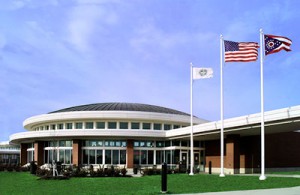 LOCATION:
LOCATION:
Milepost 170.1 – Eastbound
Between Exits 161 and 173
County: Cuyahoga
How it got its name
FUEL SERVICES:
 Sunoco - (24 Hour)
Sunoco - (24 Hour)


(Fleet Programs Accepted)
ELECTRIC VEHICLE FAST CHARGING STATIONS:

8 Superchargers - (24 Hour) up to 250kW

4 Charging hookups - (24 Hour)
RETAIL SERVICES:


FOOD SERVICES:
 Burger King - (24 Hour)
Burger King - (24 Hour) Starbucks
Starbucks
 Popeyes
Popeyes
TRUCKERS LOUNGE
- Designated truckers lounge with easy access from the 88-space commercial truck parking lot
- Separate restrooms & complimentary shower facilities
- Coin-operated washer & dryers with vended towels, sundries, and laundry supplies
- Touch & Win Ohio Lottery EZ Play video gaming terminals
OTHER SERVICES:
- Travel Mart - Customers looking for gifts, merchandise, on-the-go snacks and beverages can find them here
- Snack and beverage vending machines.
- Travel Board InfoCenter and Turnpike Television (traffic alerts and weather information
- ATM
- Ohio Lottery- Travel Mart and Sunoco are the authorized Ohio Lottery retailers at this location.
- Arcade Games
- E-ZPass – stop by the E-ZPass Vending Machine at this location to pick up an E-ZPass transponder 24 hours a day. (Passenger car customers only)
HOW TOWPATH SERVICE PLAZA GOT ITS NAME
Along the towpath of the old Ohio and Erie Canal, which lies beneath the Ohio Turnpike’s Cuyahoga River twin bridges seven miles east of the Towpath Service Plaza, straining mules once pulled the canal barges that brought improved transportation and prosperity to Ohio in the 1830s and 1840s. It was close by the old towpath that the first shovel full of earth was overturned on October 27, 1952 to start construction of the Ohio Turnpike, which provides in the mid-twentieth century another great step forward in expanding Ohio’s markets and improving its main avenues of transportation.
The towpaths along the old canals were built on compacted earth fills, like the top of a dam, and offered a solidly supported roadbed along which horses or mules pulled the canal boats. The paths were six feet or more in width and ran along the side of the canal nearest the river. On the opposite side of the canal, workmen used a small “heel path”. Mules were found to be best adapted to pulling the boats and were used singly or in teams of two or three in tandem. Horses were generally too nervous for the bustling canal-side life. The driver boys often raced their teams along the towpath to the locks, and there were loud and epithet-filled disputes over which boat should be first to use the locks, often resulting in fist fights.
At intervals along the canal there were large basins where boats could be unloaded and turned around. One of these – now called “Stumpy Basin” – lies just at the foot of the huge fill supporting the turnpike’s eastern approach to the Cuyahoga River bridges.
There are interesting parallels between the old Ohio and Erie Canal and the Ohio Turnpike. As with turnpikes today, construction of the canals was authorized by the state legislature to break bottlenecks in transportation. In those days public roads were a sea of mud; by 1949 when the Ohio Turnpike Act was passed public roads were a bedlam of traffic. Construction of the canals brought engineers face to face with soil problems inherited from the glacial era; the same type of problems plagued the builders of the Ohio Turnpike more than 100 years later. The canals locks, which were ingeniously devised structures built of hand-cut rock, became centers of activity around which stores and inns were built; today the intricately engineered interchanges of the Ohio Turnpike attract motels, shopping centers and service stations seeking the patronage of turnpike users.
Just as favorable reports on the success of the Pennsylvania Turnpike gave an impetus to the movement to build a turnpike in Ohio, the glowing accounts of the success of the Erie Canal in New York State influence the people of Ohio in trying to solve their transportation problems in that era by building inland waterways that would enable boats to travel between Lake Erie and the Ohio River. Ohio farmers needed outlets for their abundant harvests and urged political leaders to build the canals. Two major canals connecting Lake Erie with the Ohio River were begun with elaborate ceremonies in 1825, partially opened in 1827, and completed 20 years later. These were the Ohio and Erie Canal, between Cleveland and Portsmouth, and the Miami and Erie Canal, between Toledo and Cincinnati. These 813 miles of canal gave the infant industries of Ohio new markets; boosted wheat from $.20 to $.70 a bushel; attracted thousands of immigrants to the state; and connected interior Ohio with New York and the Atlantic Coast, with New Orleans and the Deep South and, through these, with the trading centers of foreign countries. In its route across northern Ohio, the Ohio Turnpike crosses the remnants or locations of both of these canals, and of still another – the Ohio and Pennsylvania Canal – which paralleled the Mahoning River.
The first portion of canal opened in Ohio was the section of the Ohio and Erie Canal now spanned by the Cuyahoga River bridges near the Towpath Service Plaza. Akron owes its very existence to the canal, having been established in 1825 at the summit of the canal route, in preparation for the influx of business activity that the opening of the canal was expected to bring. On July 3, 1827, the first boat to sail the canals – the “State of Ohio” – was launched at Akron amid speeches, toasts and cheers and sailed the 27-mile route to Cleveland. The boat’s arrival at the lakefront city heralded the beginning of a phenomenal boost in Cleveland’s population and commercial importance.
Cleveland might not have been the Lake Erie terminal for the canal had it not been for the efforts of a young Cleveland attorney named Alfred Kelley. For five years he worked to overcome financial and legal hurdles to realize his dream of linking Cleveland with the Ohio River. Then as Canal Commissioner he abandoned a rich practice and lived in a shack along the muddy backs to oversee the canal construction work.
Other sprouting villages – Newark, Chillicothe, Columbus, and Toledo – rapidly became cities as a result of the Midas touch of Ohio’s canals.
Life along the canals was rowdy and carefree. Saloons sprang up at the locks. “Luxury” excursion boats cruised up and down the canal carrying merrymakers at two or three miles per hour. Passenger fares were one-half cent a mile. Sleeping accommodations on the packets were somewhat primitive, consisting of three-foot shelves with straw mattresses, and clouds of mosquitoes made sleeping even more difficult. Church people complained that the canals brought undesirable elements to the quiet Ohio countryside.
The Ohio and Erie Canal, which was at least 26 feet wide at the bottom, 40 feet wide between the towpaths, and four or more feet deep, cost nearly $8,000,000 to build. In 1840 there were 420 boats – barges, line boats and packets – in the first 100 miles south of Cleveland. Immigration filled up the state so rapidly and productivity increased with such speed that the building of railroads across the state in the 1850s did not at first affect canal business seriously. Packet boats did a brisk business. The trip between Cleveland at the northern end and Portsmouth in the south was advertised as an 80-hour journey; between Columbus and Portsmouth a day sufficed. Eventually the speedier transportation offered by the railroads being built into every nook and corner of the state brought about the canal’s decline. Traffic moved sporadically and by the beginning of the twentieth century the Ohio and Erie Canal had become a respectable ghost, filled up in places, dry in other localities, used here and there for a fishing pond or a skating rink. The towpaths became overgrown with trees and bushes. Some of the canal beds were filled with earth and used as grades for interurban lines, railroads and highways.
Today efforts are being made to get the state to restore remnants of the canal and maintain them as they were, including old-time canal boats pulled by mules along the towpaths. The word “towpath” has almost gone out of use; perhaps the Towpath Service Plaza will at least keep the name alive close by the scene of the busy towpaths of an earlier era.